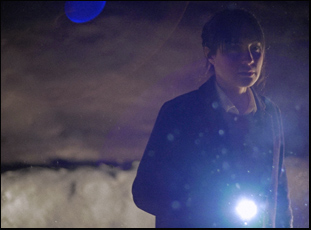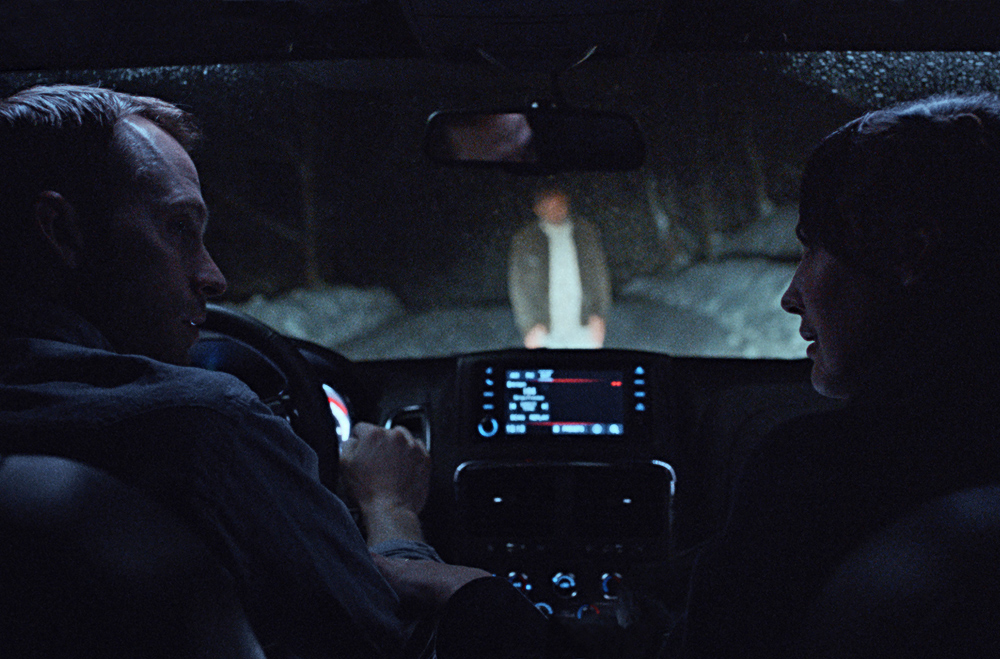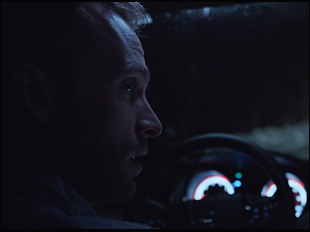“So what’s the move here?” Jake (David Call) asks his wife Lydia (Sarah Tihany) innocently enough in “Whiteout,” coming to a full stop in the snow as the two see a disheveled man (Patrick M. Walsh) in the middle of the road as they’re on their way home. One wonders how the man got there as there’s been no other cars, let alone people, for miles on Route 42, but when confronted with whether or not they should give him a ride as he looks back at them in relative comfort, director Lance Edmands finds how the inside of the car gets heated well beyond a working radiator as the couple engages in an argument that grows increasingly tense and exponentially more personal. In a single unflinching take, the filmmaker crafts an unshakeable thriller that may be just 11 minutes long, but proves to be a worthy follow-up to his searing 2013 drama “Bluebird,” and six years after that film’s premiere at the Tribeca Film Festival, Edmands is making a triumphant return and graciously took a few minutes to talk about pulling off the one-shot wonder, getting both the whole world narratively and himself and a crew of six figuratively into the car and the blessing of a real snow storm.
It was two different things. I had been wanting to make a new narrative piece and I had always had this image kicking around in the back of my head of this man in the middle of the road in the middle of the night, just lit up with headlights and how eerie and strange that would be. I started asking myself questions – where did this man come from? Who’s in the car? What does the man want? And Sarah [Tihany] and I have been working together on a few other things – we made a short film last year and I pitched this concept to her and I didn’t really know where it was going, but the two of us just started throwing things back and forth. Sarah and I are a couple, so we naturally strayed to the place where if the two of us were in a car and we came across this man, what kind of conversation would we have and how we would debate whether or not this man needed help or whether he was possibly a threat. We started thinking how this outside presence could find its way into this relationship and start to pick apart the underlying insecurities of this couple at the seams.
Basically I just started talking about it to Sarah one day and she went off into the other room and came back a few hours later with this 10-page script and I thought it was great. Then I always wanted to shoot something that was done in a single shot, partly for the challenge of it as a filmmaker to see whether I could make something that felt engrossing and meaningful without any cuts, but I really wanted that concept to be married to the content of the story and not just be a stunt. I felt this story was actually perfect for that because not only does the real time add to the tension, it also puts the viewer literally inside the car like a third passenger with these people and makes you perhaps question yourself about what you might do in this situation.
And at one level, it’s just about this couple fighting and their relationship and the spookiness of the scenario, but on the other hand, there’s also this almost larger political element where as a society, there’s a lot of debate about whether people need help or whether they’re a threat with this idea of inside and outside and safety bubbles and people who don’t have shelter or protection. I feel like being inside that bubble with the characters from a perspective standpoint was really resonant [with] people who are comfortable in their space who may be suspicious of who is coming in, maybe invading their space, and the kind of conversations that people can have can distract us from the true situation of what’s in front of us, the true need of that individual, and the sense of privilege that comes from the position of even being able to discuss what to do sometimes [gets in the way to the point] it doesn’t matter anymore if it’s a threat or something that needs help. By then it’s too late. So it was this whole stew of ideas that brought the project together.
When it is a single take like this, what’s the prep for that like?
It’s all preparation because the actual shoot itself is just one night. It was four or five hours of filming once we got everything set up and then it’s a 10-minute take and then you cut and then you start again. But it did take a lot of preparation. We rehearsed it just driving around the streets in Brooklyn with just me and the actors, figuring out the timing of everything and how long it would take — you would [time out] getting out of the car and how far you would have to walk to be in the right blocking position and all of that. And we would have to rehearse the camera moves — when the camera’s going to push in and when it’s going to pull out and where the focus was going to be at any given time. It took a few takes to get it right, to get all of the pieces together at the right time, but once we were able to get it down, we were able to keep going and subsequently with every take, we were able to get it tighter and tighter, hitting our marks closer and closer until everything was really working perfectly in concert. When you’re making a small thing without a lot of money, all the pre-planning is relatively easy to do and if you can do it all in one night like we did, you actually keep the size of production pretty small because then it’s just that execution.
The car provides a nice level of ambient light from the dashboard – were you looking for something specific in that regard?
Yeah, it was hard to find the right car because it needed to be big enough to fit everyone in the back — we had the assistant cameraman, the DP, the sound guy and me, all crammed back in there and there’s actually a little dolly, so the camera can move back and forth. And originally, I wanted the light to all be motivated from the dashboard, but that was tricky because I actually wanted to find an older car so that everything wasn’t like LED panels because those don’t have quite the same effect of the glowing dash. This car [that we used] did have an LED panel, but it was a much smaller one, so I was able to make that the right brightness so it wasn’t overwhelming the frame, but it was also giving off the right amount of light, so the car was definitely one of the trickier parts to find the right one.

Well, it’s funny because it was written for a snowstorm from the beginning, but I thought it would be an insane miracle if we got a snowstorm. I assumed I would have to do something digitally or the concept would have to change slightly, but when we got up there, it happened to snow on the day we were shooting…a lot actually. We got snowed in and the crew got stuck at the place we were staying because all our vehicles couldn’t get out of the parking lot. So it was like a real legitimate snowstorm and it was just crazy luck because I didn’t have to do anything to it in post-production.
We shot it in the Catskills in upstate New York. A friend of ours owns a nice little hotel up there, and they converted all the rooms, so we could put each of the crew members in a room and then in the mountains, we had found this perfect road we were going to film it on, but then it was snowing so bad we couldn’t actually use our original road because it was too steep. So we had this last minute change where we ended up shooting along this country road that actually went right in front of the hotel where we were staying, but because it was a snowstorm, there was nobody around and we didn’t have to worry about any other cars or anybody being out on the roads. It ended up working out perfectly.
It’s unusual to have your composer and sound designer be the same person – Mark Henry Phillips – but it’s all of a piece. What was it like to work on the sonic part of this?
He’s great and I’ve done a lot of different things with him, from shorts to commercials and little documentary works, so I already had a pretty good sense of his style. He’s done a lot of podcast work, like “Serial” and “Homecoming,” so he’s got a lot of experience sound designing for stuff that doesn’t even have a visual component to it at all and I had always imagined this film could work with your eyes closed. There’s such a forced perspective in the movie because of this one shot inside the car that this concept of perspective and storytelling with minimal clues would be perfect for it – for example in the film, the windshield wipers are this sound design element that almost becomes a character. The squeak of the wipers are almost commenting on or punctuating what’s happening with the dialogue and there’s something almost comical about it, like Tati and the squeaky chair in “Playtime.” We played with how loud that was for different moments and it progressively gets louder as the film goes on and it becomes more and more of an annoying thumping sound. It was fun to really hone in on these little details because so much of it is so quiet that it tunes into these little details and when it does get loud, it was fun to just make it as loud as we could and really put a lot of banging in the subwoofer and try to scare people.
And because there’s a lot of moments where their backs are to the camera, you don’t necessarily see their mouths moving, so we were able to use some of the different takes for the vocal performances and there was almost some old school style radio editing, so it was definitely really fun. The music side of it was similar where it was like how much is music, how much is sound design and trying to ride that line [where it’s] something that comes in that feels almost like the environment itself and isn’t necessarily layered on top.
How many takes did you wind up doing?
In the end, I think there were eight full takes and then a handful of aborted takes. A few times, we went and after the first five minutes, something got fucked up with the camera or we just decided to cut it short and start over because that’s the thing — you have to get it right all the way through, otherwise there’s no point because there’s no element of it you can save. I think we ended up using take six for the final [version you see in the film]. And it’s funny because [after take six] I was like, “Yeah, that was pretty good. Let’s do another one.” And then we did take seven and then I thought, “Okay, that’s great. That totally worked. Let’s just do another one for safety.” And then we did another one and it was like, “Alright, I guess that’s it.” And little did I know we had it two takes before, but there was no way to know until you really go in and watch it all back and notice all the little things that in the moment you may not have been noticing.
The most stressful thing for me was just trying to figure out what I should be paying attention to and making sure I’m not missing something while it’s happening. I’m trying to pay attention to performances, but I’ll find myself paying attention to one actor and then I’m like, “Oh no, I haven’t been paying attention to what the guy’s doing out the window the whole time.” And then I’m also super-aware of what the camera’s doing and [wondering] is the camera’s hitting its marks? There was this feeling [at the end] of “I guess we got it and it’s great,” but also in the back of my head, I’m like, “Did we get it?” Because I’m never going to know until I go through and watch all these down in the quiet solitude of my home as opposed to super stressed out in the back of a van where I’m crunched into a small ball, barely able to see or hear anything because I’m on top of the sound guy. I didn’t really know until we brought it back and I watched it on the big screen and then I was like, “Yeah, that’s it.” But that was a challenge. I like to make things a little bit hard for myself, otherwise there’s no point.
“Whiteout” will screen at the Tribeca Film Festival as part of the Shorts Program: WTF at the Village East Cinemas on April 26th at 11 pm, April 27th at 11 pm, May 3rd at 6:45 pm and May 4th at 8:30 pm.





